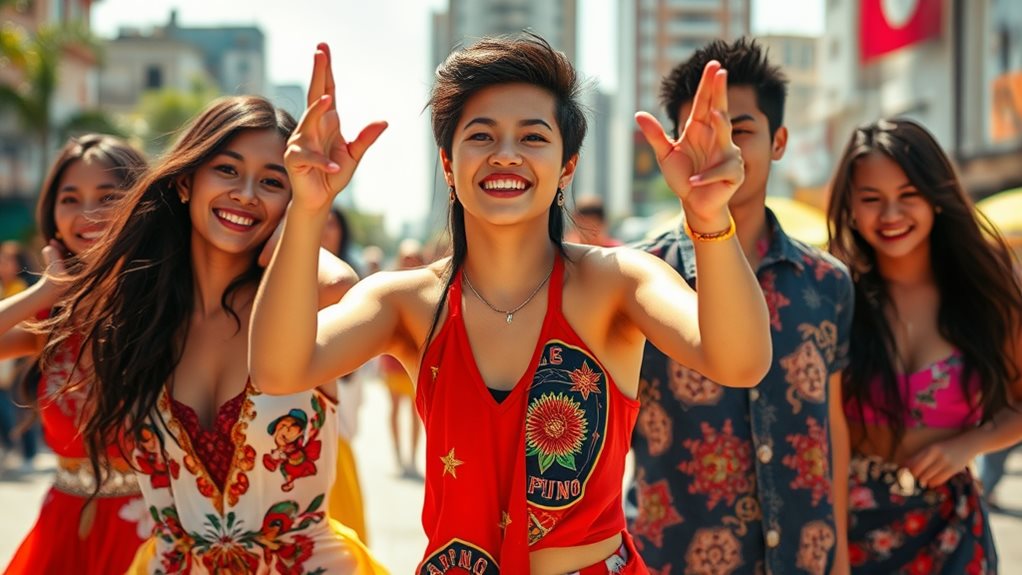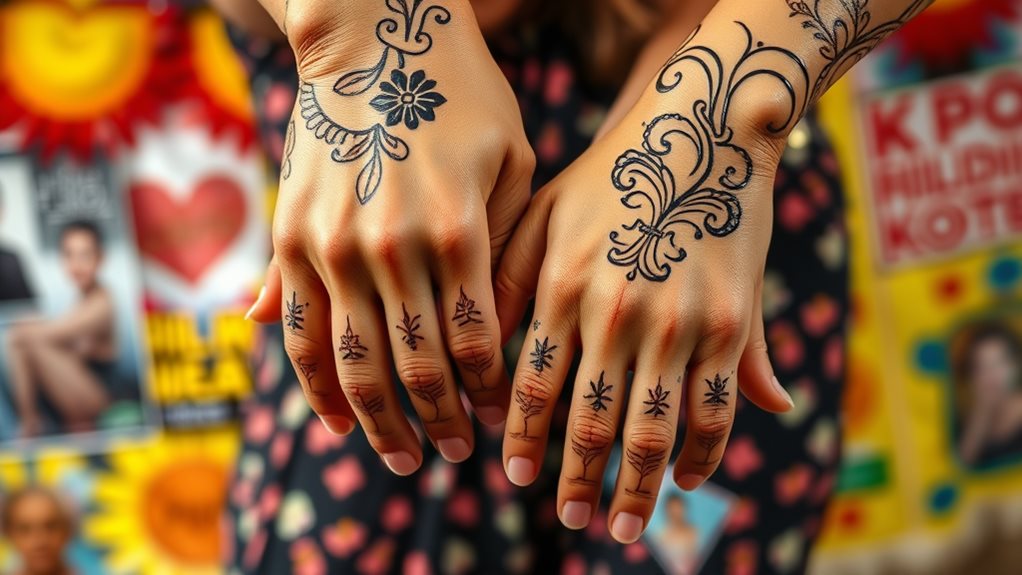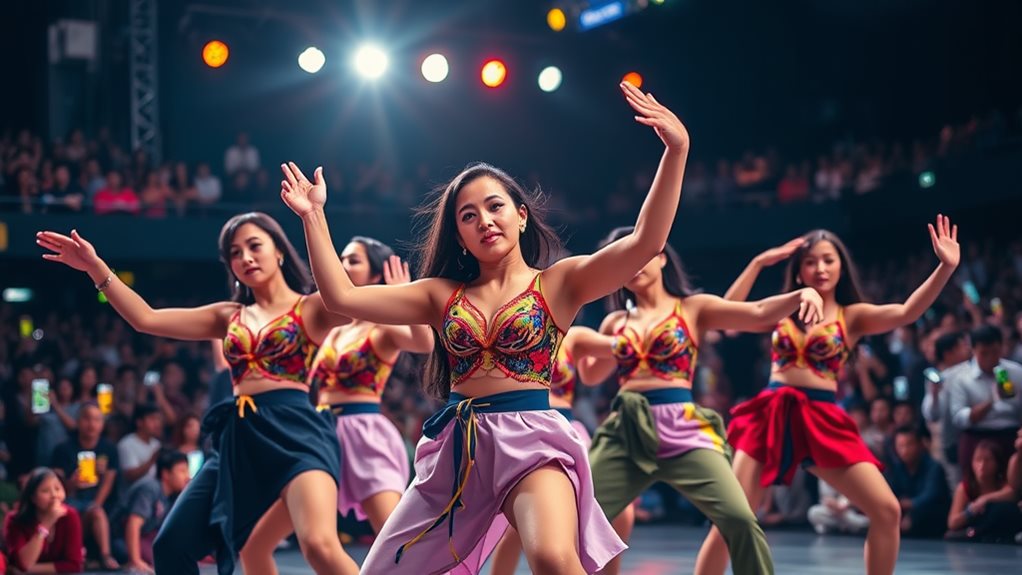The Rise of K-Pop in the Philippines Transformed Filipino Dance Culture
K-pop's popularity in the Philippines led to an increase in dance cover groups, who initially replicated idol choreographies. This sparked a cultural exchange between Korean and Filipino styles, giving birth to a unique fusion of dance movements.
The Emergence of P-Pop and Its Impact
The blending of Korean and Filipino dance styles resulted in the creation of P-pop, a genre that showcases this fusion. P-pop has not only increased the visibility of the local dance scene but also had a significant economic impact. The rise of P-pop has created opportunities for Filipino dancers and choreographers, providing them with a platform to showcase their talents.
Strong Fan Engagement Amplified the Influence of K-Pop on Filipino Dance Culture
The strong fan engagement with K-pop and P-pop has created a vibrant community around dance in the Philippines. This community has played a crucial role in amplifying the influence of K-pop on Filipino dance culture, leading to the evolution of the local dance scene. For instance, dance competitions and events have become increasingly popular, with many Filipino dancers competing and performing to K-pop and P-pop songs.
The Evolution of Filipino Dance Culture
The influence of K-pop on Filipino dance culture has resulted in a more diverse and dynamic dance scene. Filipino dancers now have the opportunity to learn from and be inspired by various dance styles, including Korean and Western styles. This has led to the creation of new and innovative dance movements, further enriching the Filipino dance culture.
K-Pop's Arrival in the Philippines

Korean culture's presence in the Philippines was established before K-pop's rise to fame. Korean missionaries arrived in the country in the 1970s, while early settlers and war brides also made the Philippines their home.
The 1990s saw increased economic migration and the expansion of Korean businesses, laying the groundwork for a more substantial Korean community.
The early 2000s marked a turning point in K-Pop history in the Philippines. The Hallyu, or Korean Wave, swept across the country, introducing K-dramas, K-pop, K-movies, and other forms of Korean media.
Social media's rise amplified this phenomenon, creating a vibrant online community and fostering an intense Filipino fandom. For example, fans were drawn to the music, style, and personalities of artists like TVXQ and Super Junior.
The growth of K-pop created a market for Korean goods and services in the Philippines. Korean restaurants and shops catering specifically to Filipino fans opened, further integrating Korean culture into daily life.
The success of K-pop wasn't just a shift in musical tastes; it was a catalyst for cultural exchange. The Philippines became a significant player in the global K-pop scene, as evidenced by the massive success of early concerts featuring artists like Rain and Girls' Generation.
The arrival of K-pop in the Philippines led to a deeper interconnection between both cultures. The country's engagement with K-pop shaped the landscape of Filipino fandom and paved the way for future cultural exchange.
This connection was evident in the thousands of fans who attended K-pop concerts and events, such as the Dream Concert in 2013 and the Mnet Asian Music Awards in 2014.
Dance Cover Groups' Rise
Filipino Dance Cover Groups Emerge Alongside K-Pop's Rise****
The rapid growth of K-pop's popularity led to the emergence of Filipino dance cover groups. These groups showcased impressive skills and creativity by meticulously recreating their favorite idols' routines. Fans honed their dance techniques and mastered complex choreography styles, demonstrating precision and synchronization characteristic of K-pop's demanding dance style.
Dedicated Performers Gain Widespread Popularity Through Social Media****
The widespread popularity of these dance cover groups was largely driven by social media. These platforms enabled groups to share their performances, connect with fans, and gain widespread recognition****.
Fan clubs and conventions further fueled this trend by providing opportunities for these groups to showcase their talents.
Impact on the Entertainment Industry
The rise of these dance cover groups also had a significant impact on the entertainment industry. These groups provided aspiring performers with a highly visible platform to showcase their talents.
As a result, many dance groups found themselves featured in music videos and concerts, boosting their popularity and the industry's growth.
Their dedication to replicating intricate choreography styles and advanced dance techniques of K-pop acts demonstrated a deep engagement with the genre, creating new opportunities and a visible pathway for talent.
Cultural Exchange's Influence

Cultural exchange between South Korea and the Philippines has had a significant impact on Filipino society and culture. The Philippine Kpop Convention, Inc. is a notable example of a fan club and convention that connects fans and fosters the Korean Wave. This convention, along with others, has contributed to the growth of K-pop in the Philippines.
Social media platforms have played a crucial role in the rapid dissemination of Korean culture, creating person-to-person connections amongst Filipino fans. Student exchange programs have further immersed fans in Korean culture, deepening their understanding and appreciation. These programs have enabled students to experience Korean culture firsthand, promoting a deeper understanding of the culture.
Local TV channels have also contributed to the popularity of K-pop by airing Korean dramas since 2005. The airing of these dramas has paved the way for K-pop's explosive popularity in the Philippines. This hasn't only promoted K-pop but also broader Korean cultural understanding, strengthening Philippines-Korea ties.
The influence of K-pop extends beyond entertainment, with a significant impact on social values. K-pop has promoted respect and fostered stronger community bonds among Filipino fans. The hybrid influences of K-pop have resonated with Filipino fans, who see cultural similarities due to existing interactions with Korean immigrants in Manila.
K-pop has also influenced traditional Filipino dance elements, which have been incorporated into modern K-pop-inspired routines. This has created unique hybrid influences and showcased Filipino cultural heritage. Additionally, the popularity of Korean cuisine has increased, with many Filipino restaurants now offering Korean dishes.
The cultural exchange driven by K-pop has spurred educational and cultural collaborations between the Philippines and South Korea. This has enriched both societies, promoting a deeper understanding of each other's cultures. The impact of K-pop on the Philippines is a testament to the power of cultural exchange in promoting understanding and appreciation between nations.
P-Pop Dance Covers Emerge
P-pop dance covers have emerged as a distinct genre, showcasing a creative fusion of styles. Initially, many Filipino groups replicated K-pop choreography to hone their skills and build a fanbase.
However, these groups eventually shifted towards incorporating traditional Filipino influences into their dance routines.
This shift led to the incorporation of traditional dances like tinikling, pandanggo sa ilaw, and carinosa**** into contemporary styles such as hip-hop and street dance.
The result was a unique fusion that blended traditional and modern elements seamlessly.
Groups like SB19, BGYO, Alamat, BINI, and Bituin exemplify this trend.
SB19 integrated tinikling into their song "Alab," while BGYO incorporated pandanggo sa ilaw and carinosa into "The Light."
These modifications reflect a creative evolution in P-pop dance covers, celebrating Filipino identity and showcasing the artistry and versatility of P-pop dancers.
The incorporation of traditional influences into P-pop fusion dance has contributed to a uniquely Filipino aesthetic.
This aesthetic is characterized by vibrant energy and cultural authenticity, reflecting a shift towards greater cultural authenticity in P-pop dance covers.
How Has Filipino Hip-Hop Evolved in Response to the Influence of K-Pop on Dance Culture?
The evolution of hiphop music in the philippines reflects a vibrant fusion of local and global influences, notably the rise of K-Pop. Filipino artists have embraced intricate dance styles and catchy melodies, blending traditional elements with contemporary flair, ultimately reshaping the hip-hop landscape and captivating a diverse audience.
Industry and Fan Impact

K-pop has significantly influenced the Philippine entertainment industry and its fans.
The rise of numerous dance cover groups on social media platforms reflects the industry's response to the burgeoning K-pop fandom. For instance, the popularity of dance cover groups has fueled the growth of Hallyu clubs in the Philippines. The country has shown exceptional numbers, demonstrating the substantial growth of K-pop fan communities. Sold-out K-pop concerts have also become a common occurrence, showcasing the high demand and substantial economic benefits generated by this phenomenon.
K-pop's impact extends beyond music, influencing local businesses and entertainment options by promoting Korean culture**. This has led to the creation of Korean-themed cafes**, restaurants, and shops in the Philippines.
Furthermore, K-pop has encouraged the production of local content inspired by Korean dramas and music.
Fan engagement is crucial to K-pop's success, with Filipino fans displaying dedication and creativity through social media and fan clubs. Fans actively participate in creating dance covers, attending concerts and conventions, and engaging in online discussions.
This level of fan dedication fuels the economic benefits seen across the entertainment and retail sectors. The strong fan engagement fosters strong social connections, increasing favorable views towards Korea and boosting cultural exchange.
Questions and Answers
What Are the Economic Benefits of K-Pop Fandom?
The K-pop industry generates significant economic benefits through various channels. Merchandise sales are a substantial contributor, with fans purchasing items such as clothing, accessories, and collectibles featuring their favorite artists' logos or images. For instance, BTS's merchandise sales alone have been reported to exceed $1 billion annually.
Lucrative fan events also play a crucial role in the industry's economic growth. Fan meetings and conventions draw large crowds, generating revenue from ticket sales, sponsorships, and on-site merchandise sales. These events provide a platform for fans to connect with each other and their favorite artists, fostering a sense of community and loyalty.
Concert tourism is another significant contributor to the K-pop industry's economic benefits. Fans travel from around the world to attend concerts and music festivals, boosting local economies through hotel bookings, dining, and other tourism-related activities. The economic impact of K-pop concerts is substantial, with some events generating millions of dollars in revenue.
Lastly, substantial streaming revenue fuels the industry's growth. K-pop fans worldwide stream their favorite artists' music on platforms such as Spotify, Apple Music, and YouTube, generating significant revenue from royalties and advertisements. This revenue stream has been instrumental in promoting K-pop globally and supporting the industry's continued growth.
How Has K-Pop Influenced Filipino Fashion Trends?
K-Pop has significantly influenced Filipino fashion trends, resulting in a noticeable shift in styles and preferences. Bold colors and vibrant hues have become increasingly popular, as seen in the likes of K-Pop groups such as BTS and Blackpink, who often incorporate bright colors into their music videos and performances. Filipino fashion has also adopted gender-neutral styles, allowing individuals to express themselves freely without adhering to traditional gender norms. Streetwear has become a staple in Filipino fashion, with brands such as H&M and Uniqlo collaborating with K-Pop idols to promote their latest collections. Fashion collaborations between K-Pop groups and local designers have further solidified this trend's prominence, showcasing the blending of Korean and Filipino styles.
What Challenges Do P-Pop Groups Face?
P-Pop Groups Face Significant Challenges in the Industry
One of the primary challenges P-pop groups encounter is intense competition. With numerous groups vying for attention, it can be difficult for new groups to stand out and gain a loyal fan base. For instance, groups like SB19, BINI, and MNL48 have already established themselves in the market, making it harder for newer groups to compete.
Another challenge P-pop groups face is demanding training difficulties. These groups often undergo rigorous training sessions to perfect their singing and dancing skills, which can be physically and mentally exhausting. This intense training regimen can also lead to injuries and burnout if not managed properly.
In addition to competition and training difficulties, P-pop groups must also navigate cultural adaptation. As a fusion of Filipino and Korean pop culture, P-pop groups must balance their local roots with international influences, which can be a delicate task. For example, adapting to different cultural norms and expectations can be overwhelming for some groups, especially those that are just starting out.
Lastly, securing sufficient industry support remains a significant challenge for P-pop groups. Many groups struggle to find adequate funding, management, and resources to help them produce high-quality music and performances. This lack of support can hinder their growth and success in the industry.
Are There Any Negative Impacts of K-Pop's Influence?
K-pop's influence has a negative side. Two main concerns associated with K-pop's influence are cultural appropriation and extreme fan behavior.
Cultural appropriation occurs when K-pop groups adopt cultural elements from other countries without understanding or respecting their significance. For example, groups may incorporate traditional African or Native American clothing into their music videos or performances without proper knowledge or credit. This can be perceived as disrespecting the cultural heritage of the communities from which these elements originate.
K-pop's impact on mental health is also a concern. Extreme fan behavior, such as obsessive stanning, can lead to mental health issues like anxiety and depression. Additionally, the pressure to maintain a perfect image and constantly produce content can take a toll on the mental health of K-pop idols themselves.
Furthermore, K-pop can also have a significant financial impact on fans. Fans may spend large amounts of money on merchandise, concert tickets, and other K-pop-related items, leading to financial burdens. This can be particularly problematic for fans who are not financially stable or who prioritize K-pop expenses over essential needs.
How Has K-Pop Impacted Filipino Social Values?
K-pop has significantly influenced Filipino youth identity, leading to a cultural exchange between the two nations. This cultural exchange has been driven by the popularity of K-pop groups such as BTS and Blackpink, which have gained massive followings in the Philippines. As a result, Filipino youth have been exposed to a new wave of cultural values that often blend traditional and modern elements.
The influence of K-pop has shifted traditional Filipino social norms. For instance, K-pop's emphasis on self-expression and individuality has inspired many Filipino youth to be more confident in their own identities. This shift is evident in the growing popularity of K-pop dance groups and cover performances in the Philippines, where young people can express themselves freely.
K-pop has created new forms of cultural capital in the Philippines. Cultural capital refers to the social assets that give individuals an advantage in society. In the Philippines, being knowledgeable about K-pop can be a valuable form of cultural capital, especially among young people. For example, K-pop fans in the Philippines often participate in online forums and social media groups to discuss their favorite groups and share their knowledge with others. This shared passion for K-pop has created a sense of community and belonging among Filipino youth.